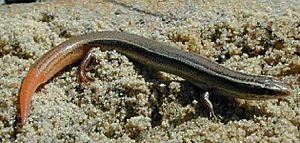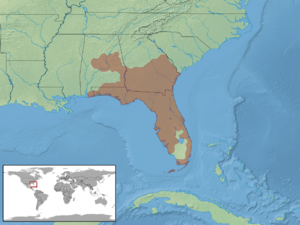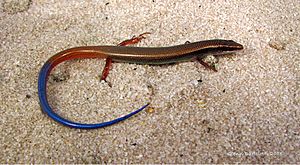Mole skink facts for kids
Quick facts for kids Mole skink |
|
|---|---|
 |
|
| Conservation status | |
| Scientific classification | |
| Genus: |
Plestiodon
|
| Species: |
egregius
|
 |
|
| Synonyms | |
|
|
The mole skink (scientific name: Plestiodon egregius) is a small type of lizard. It lives only in the Southeastern United States. These lizards are known for being quite shy and often hide underground.
Contents
Meet the Mole Skink: What is it?
The mole skink family has five different types, called subspecies. Think of them like different breeds of a dog, but for lizards! Each subspecies has its own unique features and lives in specific areas.
- Florida Keys mole skink (P. e. egregius): This one lives only on some of the Florida Keys islands.
- Cedar Key mole skink (P. e. insularis): You can find this skink only on three islands near Cedar Key.
- Bluetail mole skink (P. e. lividus): This skink lives in central Florida. It shares its home, called Florida scrub, with another special lizard, the Florida sand skink.
- Peninsula mole skink (P. e. onocrepis).
- Northern mole skink (P. e. similis).
Scientists first described the mole skink in 1859. Over the years, its scientific name changed a few times. In 2005, scientists decided to put most North American skinks back into the Plestiodon group.
Protecting Mole Skinks: Are They in Danger?
Some types of mole skinks need our help. The Florida Keys, Cedar Key, and bluetail mole skinks are protected. The bluetail mole skink has been listed as a federally-threatened species since 1987. This means it's at risk of disappearing forever.
The biggest dangers to these skinks are:
- Habitat loss: When people build homes, shops, or farms, the skinks lose their natural homes.
- Over-collection: Some people try to catch too many of these lizards as pets, which harms their wild populations.
The other two subspecies, the peninsula and northern mole skinks, are more common. The northern mole skink can also be found in southern Alabama and Georgia.
Where Do Mole Skinks Live?
Mole skinks love to live in sandy areas like sandhills and scrublands. They are very good at burrowing. They often bury themselves underground to stay safe and cool. They especially like to warm up in the top layers of dirt mounds made by Southeastern pocket gophers.
Mole Skink Life Cycle: Babies!
Mole skinks are ready to have babies when they are about one year old. They usually mate in the winter. In the spring, the female mole skink lays her eggs. She lays about three to seven eggs in a shallow nest. This nest is usually less than 30 centimeters (about 12 inches) deep.
The eggs take about 31 to 51 days to hatch. During this time, the mother skink stays near the nest to protect her eggs.
Bluetail Mole Skink: A Closer Look
The bluetail mole skink is a small, shiny lizard. It has a smooth, tube-shaped body and is usually brownish. Young bluetail mole skinks have a bright blue tail. This blue tail makes up more than half of their total body length! As they get older, or if their tail grows back after being lost, it often turns pinkish.
Their legs are quite small. They use them to walk on the surface. But when they move through sand, they "swim" through it without using their legs much. During the time they mate, male bluetail mole skinks get colorful orange patterns on their sides. These skinks usually grow to be about 9 to 15 centimeters (3.5 to 6 inches) long.
Bluetail Mole Skink: Home and Habits
The bluetail mole skink shares its home with another endangered lizard, the Florida sand skink. But they don't compete for food or space. The sand skink finds its food underground. The bluetail mole skink, however, hunts for its food on the surface.
When a bluetail mole skink feels threatened, it has a clever trick. It might show its tail to distract a predator. If that doesn't work, it might even pretend to be dead!
What Do Bluetail Mole Skinks Eat?
Like other mole skinks, the bluetail mole skink enjoys a diet of insects. They mainly eat cockroaches, spiders, and crickets.
Where to Find Bluetail Mole Skinks
You can find the bluetail mole skink in central Florida. They have been seen in counties like Seminole, Orange, and Brevard.
Bluetail Mole Skink: Why It Needs Help
The bluetail mole skink is a federally-threatened species. This means it is protected by law because its numbers are low. Efforts are being made to protect its habitat and help its population grow.



